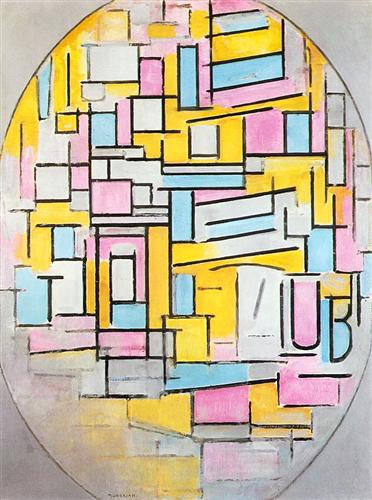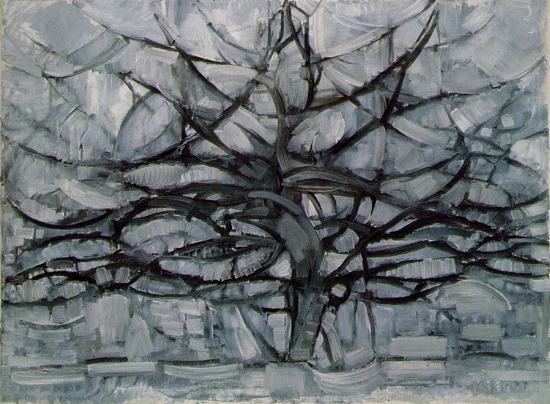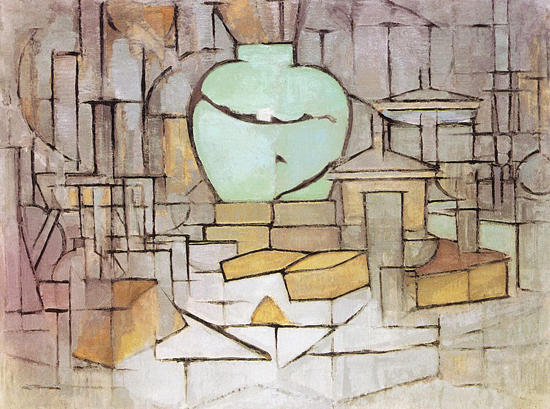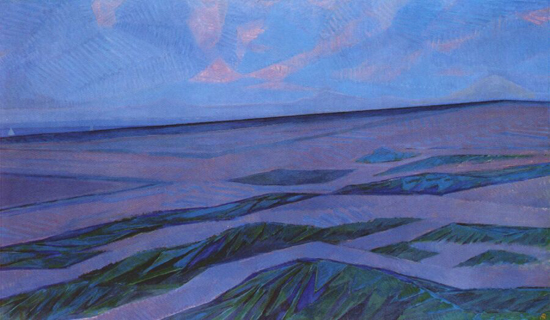Perpetual Ripplets: Mondrain: Part II
Yuko Otomo
September 2017
 Composition with Oval Color, 1914, Wikiart
Composition with Oval Color, 1914, Wikiart
Piet Mondrian: 1872 – 1944
Part Two: Room # 4, 5, 6
Room 4
Cubism. Nothing is more powerful than the impact Mondrian felt as he saw works by Cezanne & the early Cubist works by Picasso & Braque in Amsterdam in 1911. In one of his writings in the book I re-read prior to this piece on the retrospective, “Toward the True vision of Reality,” Mondrian clearly admits the intensity of the influence of Cubism & says “Of all abstractionists, I felt that only the Cubists had discovered the right path.” As Appolinaire’s words say on the exhibition panel: “Mondrian descends from the Cubists, but does not imitate them. His personality remains entirely his own -” he again uses the influences without being beaten by them to make them his own by digesting them effectively. It is very impressive to see him deepen & clarify his own direction without being swallowed by these powerful waves of influence. It is so rare to see an artist with such a clear sense of one’s own investigations & with such a will to search. It is as if, whenever he encounters a new influence, his already awakened, clear consciousness is embracing influences only for his own benefit, instead of his being woken up to a new idea.
He further solidifies the conviction of his direction while working on a single subject “trees,” as with his Study of Trees I & II. His signature changes to P. Mondriaan & further to PM. As he moves to Paris to study Cubism, he tries to understand the background logic of the thought process that shifts from Nature to Abstraction through these studies of “trees.” He repeats the studies of color & space division particular to Cubism. Flowering Trees (1912) shows a quiet joyfulness. Strangely, in his case, struggles never accompany agony. Through Grey Tree (1911 oil on canvas) & The Sea (1912 oil on canvas), he deepens his search using the concept & logic of Cubism. Flowering Apple Tree (1912 oil on canvas) delivers a new sense of spatial division, reaching toward a universal balance. The effect caused by this new sense of a universal balance of elements is one part of what Mondrian has been searching for.
An awareness of the picture plane being the world; the resonance created by the balance between one element and others & their effects on our visual cognition. The possibility of realizing the “Idea” proved by the effects caused by this new visual cognition, the picture plane itself becoming the subject, the role for the subject of the painting that has been traditionally predominant totally loses its reason for existence here. This new consciousness of space has become nothing but the backbone concept of Abstract Art. As Composition & Trees II (1912 oil on canvas) demonstrate, the consequent idea of “composition” clearly floats up within this new consciousness of space. Once you have come to this point, it is not overstated to say that you’ve almost completed establishing a foundation for Abstract Art. On The Tree A (1912 oil on canvas), his signature further changes to MONDRIAN with the disappearance of Piet. Tableau No. 2 (1913 oil on canvas), according to the accompanying panel’s explanation, shows the climax of his Cubist approach with a neutral title. Tableau No. 3, which as well shows a cubistic influence with its oval picture plane. Studying further, Mondrian learns the process & the mechanism of “intuitive thinking.” The logic of intuitive thinking helps the artist to develop his own clear sense of grasping the matter through series after series of trainings & trials. Unlike intellectual thinking, intuitive thinking resides as the logic outside of lingo-logic. That is why, even more so, you cannot achieve it through command of the mind alone. It is only possible when the artist learns to capture it through actual “concrete” experimentations on the subject. Composition Tree I (1912 oil on canvas) & other works are done for the purpose of training himself to learn to have an actual physical/metaphysical eruption & flow of intuition.
 The Grey Tree, 1911, Wikiart
The Grey Tree, 1911, Wikiart
Room 5
A room titled “Paris Façade”. A clear awareness of autonomy. Here, the colors pink, yellow & blue of his early works appear again. It is a new emergence of these same colors that have gone through Cubistic coloration. Mondrian further studies the relationship & the differentiation between Nature & Abstraction. Seemingly geometric works are the result of the process of intuitive thinking & his thoughts on abstraction. In this period, he invents a simple wooden strip frame. “I was the first to bring a picture forward from its frame, as opposed to setting it within one – by doing this. I gave the picture more real existence…” he explains. He further makes an effort to make a picture “a real existence.” Composition No. II (1913), Tableau No. 2 (1914), Tableau No. 1 (1914), Composition No. XII (1913), Composition No. IV (1916), Composition with Color Planes (1914), Composition in Oval with Color Plane (1916 — all are oil on canvas)… . The works done in this study-series are displayed in this room.
I wonder how many works would be here if every study work had been collected to be exhibited here? As I get extremely moved by his intense & vigorous attitude of studying , which can be called “an obsession,” I am amazed to notice that there is no hint of a negative sense of agony attached to these works. Although these works, born out of his vigorous involvement in studying the case, have a similarity in how they look, they are not the result of variations of a theme. Each one of them has an independent sense of autonomous existence, each emanating the solid weight of its own “being”.
Having reached this point, Mondrian tries to eliminate the traditional understanding of the meaning of the background. “to undermine (* my Italics) the traditional distinction between figures & background”… he tries to free the roles of “the solid” & “the void”. They start to live as equal & unified elements in the picture plane. Solid = Void. When I observe these works, I witness some residues of traces of Nature, but they do not bother me since all I see is Mondrian’s intense efforts to activate his thought in actual works. In Composition 1916 (1916 oil on canvas), he shows that he is training himself to learn to strengthen the intensity of the work by the purification of colors.
Back in Holland in 1914, resuming his experiments in the field, he returns to color studies after a 2 year absence from the subject through repetitive works such as Dombury Church Façade. Here, as the sense of melancholy that has been hanging in his work cleanly disappears, we witness the conviction in his action as his statement.
 Still Life with Gingerpot 2, 1912, Wikiart
Still Life with Gingerpot 2, 1912, Wikiart
Room 6
A room titled “Toward Abstraction: 1914 – 1917.” Drawings done in Holland during WWI. I visualize an image of Mondiran, vigorously pushing his search for “truth,” looking up to the starry sky on the beach of Domburg. What a sight! I wonder where his unshakable determination & particular personality comes from to support such a search through art toward ideals of a unity of humanity, as well as of spiritual unity, in the midst of the tremendous, unthinkable chaos of the first modern world war. Pier & Ocean Drawings demonstrate the study of Vertical/Horizontal to reveal Universal Rhythm. In these works, having been baptized by the words of Theo van Doesburg: “a line on its own has almost become a work of art” to free the role of “a line” from its traditional role of describing matter & things. Through works such as Ocean 1, 2, 3, 4, 5 (1914 charcoal on paper), Composition 10 in Black & White (Pier & Ocean), Pier & Ocean 1, 5, 3, 4 (1914 charcoal on paper), Mondrian successfully reaches toward Abstraction, with the natural world as a starting point. And he clearly sees “the reality” of his search in the process of a development of intuitive logic, its methodology & the direction it is taking: Plus-Minus composition.

 Dune Landscape, 1911, Wikiart
Dune Landscape, 1911, Wikiart